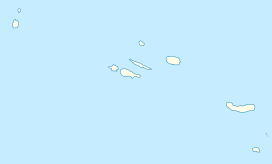Mount Pico
| Mount Pico | |
|---|---|
| Ponta do Pico | |

Aerial view of Mount Pico
|
|
| Highest point | |
| Elevation | 2,351 m (7,713 ft) |
| Prominence | 2,351 m (7,713 ft) |
| Parent peak | None - HP Pico |
| Listing |
Country high point Ultra |
| Coordinates | 38°28′08″N 28°23′56″W / 38.46889°N 28.39889°WCoordinates: 38°28′08″N 28°23′56″W / 38.46889°N 28.39889°W |
| Geography | |
| Location | Pico Island, Azores |
| Parent range | Mid-Atlantic Ridge |
| Geology | |
| Age of rock | < 230,000 Years |
| Mountain type | Stratovolcano |
| Volcanic arc/belt | Volcanic Arc |
| Last eruption | July to December 1718 |
| Climbing | |
| Easiest route | Scramble, Class 2; YDS Grade II |
Mount Pico (Portuguese: Montanha do Pico) is a stratovolcano located on Pico Island, in the mid-Atlantic archipelago of the Azores. It is the highest mountain of Portugal, at 2,351 metres (7,713 ft) above sea level, and is one of the highest Atlantic mountains; it is more than twice the elevation of any other peak in the Azores.
Historical eruptions of Pico have occurred from vents on its flanks rather than the summit crater. In 1562–64, an eruption on the southeast flank produced lava flows which reached the sea. Another flank eruption in 1718 also produced flows which reached the coast. The most recent eruption occurred in December 1718.
On 29 September 2009 there were reports from local news sources that indicated that a fumarole existing at the pinnacle of the mountain (Piquinho) began emitting volcanic gas. The region's seismic and volcanological monitoring centre (Portuguese: CIVISA Centro de Informação e Vigilância Sismovulcânica dos Açores) indicated that the phenomenon occurred in the early morning, turning intense and visible in various points throughout the island and from Faial. Although the event resulted from exceptional meteorological conditions and was visible in the Central Group, there was no liberation of anomalous volcanic gases and all other parameters fell within norms.
Mount Pico is part of the Madalena Volcanic Complex, one of three volcanological units that comprise the island of Pico, associated with three historic eruptions in 1562, 1718 and 1720. Current morphology suggests an age dating to the Holocene age, confirmed by radiocarbon dates younger than 6000 years. Structurally, this complex can be subdivided into two other sections: the Pico Volcano and the East Fissural Zone.
Pico is a stratovolcano, with a pit crater on its summit.Pico Alto is the round crater about 500 meters (1,600 ft) in diameter and 30 meters deep that tops the volcano, with Piquinho or Pico Pequeno (both names meaning "small peak" in Portuguese), a small volcanic cone, rising 70 meters within it to form the true summit. Meanwhile, the East Fissural Zone comprises several alignments of Hawaiian/Strombolian cinder cones and associated lava flows, which overflowed many of the cliffs, cut in older units and originated lava deltas (Portuguese: fajãs).
...
Wikipedia

